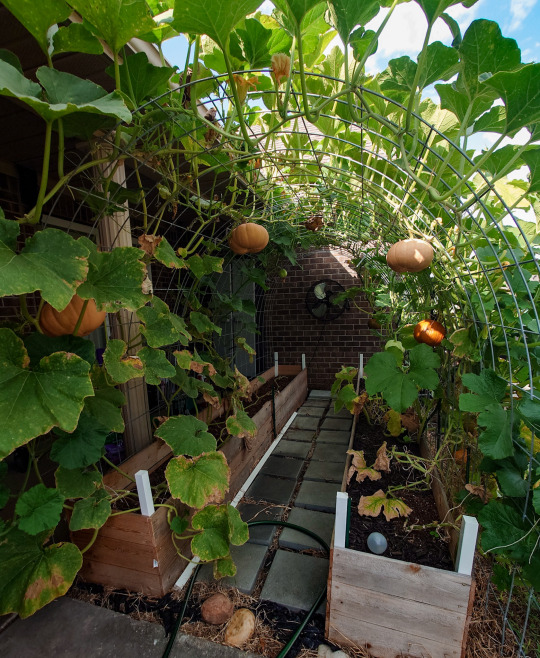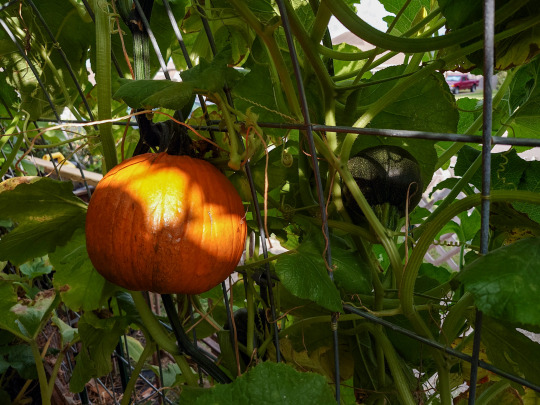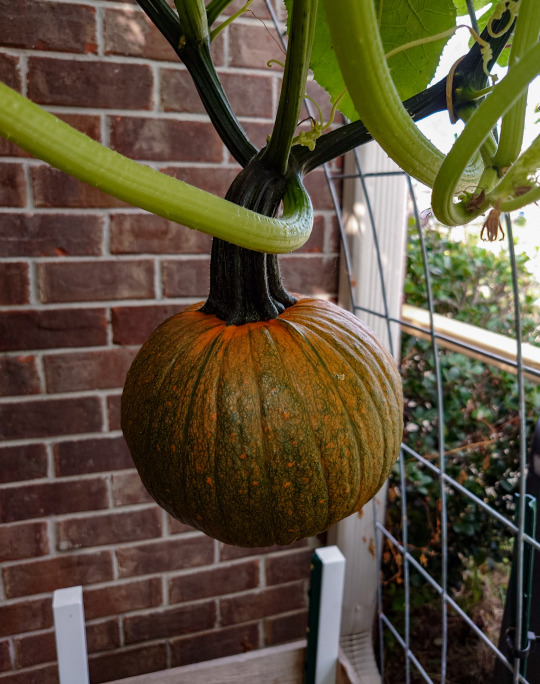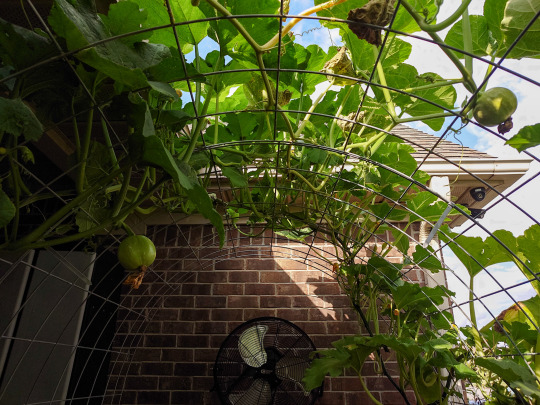Text
You wouldn't download 16 basil plants

So, you know those spindly basil plants you can get in the supermarket that are all leggy and pale, and you put them on the window-ledge and pick a few leaves from them and then they die?
Here is the hack for
turning it into a healthy plant and
making an army of clones from it so that all your friends can have one too
You will need
one parent plant
scissors for cutting the stalks
enough pots for however many seedlings you want to make
compost
one or two empty bottles
Method
Have a look at your parent plant. You'll see that each bundle of leaves comes out from a knobbly bit in the stem. That knobbly bit is called a leaf node.
Gently take hold of the very top set of leaves and count the leaf nodes on that particular stalk, counting down from the top.
If there are more than three nodes, cut the stalk just below the second leaf node.
The bit that you have just cut off is called a cutting, and it will become a new plant. To do this, we have to get it to grow roots.
Take your cutting and remove all the leaves except the four at the very top.
Fill your bottle with water and insert the cutting into the top of the bottle, with the stem completely submerged in water, and the leaves outside in the air.
Now repeat until you've taken about six cuttings, or you've taken all the cuttings available. Put them all in water-filled bottles. (I use milk bottles which hold about four stems at once with enough space for their leaves to get the sunlight, but if you're using wine bottles it might be fewer.)
Put the cuttings/bottles onto a sunny window-ledge and wait. Within about a week you should see roots beginning to grow. Keep the water topped up to the top, and let the roots grow until they are two or three inches long.
When the roots are 2-3 inches long, fill your pots with compost and water them well. Shove your fingers in the wet compost to make a space for the cutting's new roots and gently insert the cutting into the hole. Put a little bit more compost on top and firm it down, move on to plant the next one.
Providing all your cuttings get over the shock of transfer (and they probably will) you will then have 8 little basil plants like the smallest ones in my picture.
Put them back on the sunny window-ledge to let them get established and begin to grow. Congrats, you now have 8 basil plants plus the parent plant.
The parent plant
When you're taking the cuttings, you must leave at least one leaf node on every stalk. The plant can't create leaves without the nodes, and if it has no leaves it's basically going to die.
You want the plant to create new leaves and thicken up. If a stalk doesn't have more than two nodes, don't make cuttings from that stalk at all. Leave that stalk to grow.
Taking your cuttings will stimulate the plant to grow, and lower nodes which may not have had leaves on them when you got the plant, will now begin to produce them. This will make the plant bushier and stronger, but it will need a bit of extra food to help it put the extra effort in. So give it a new layer of compost on the top, water it, and put it back on the sunny window-ledge as well.
First batch cuttings
Let your first generation of cuttings grow undisturbed for a few weeks. (Water only when the soil feels dry.)
When they start looking long and thin, you want to encourage them to create side-shoots and begin bushing out. You don't want a long thin plant. It will fall over in the wind.
Look at the very top of the plant where you will see two tiny baby leaves developing. If you let them develop, the plant will continue to grow long and thin, but if you take them out it will encourage the side shoots to grow. Pinch out the tiny baby leaves right at the top of the cuttings, and very soon you'll see they start to grow outwards instead of upwards.
Second batch cuttings
After a few weeks your cuttings will look like the larger plants in my picture, and your parent plant will have grown enough to have added extra nodes. Which means that you can now take another batch of cuttings and start the process all over again.
You can pretty much keep this going all summer if you want.
Give plants away, eat fresh basil all summer and fill your freezer with bags of basil leaves for the winter :) Happy cloning!
3K notes
·
View notes
Text
The Permaculture Spiral Garden - A Great Starting Point
There is probably no other structure as popular for illustrating Permaculture in practice as the Herb Spiral. Okay, I guess I could mention the lasagna sheetmulching method or also the cob oven that tends to be the first hands-on project at a typical Permie intro session. But when it comes to showing how landscape design, zones and sectors, stacking functions, and efficient use of space and water come together in one unique structure, the Spiral Garden is unbeatable.

Turning Theory into Practice
In typical Permaculture Designer Certificate courses, but even in brief intro weekends to Permaculture, there tends to be a lot of theoretical discussions. Since the numerous design principles can be applied to any climatic region, from the tropical to the subarctic, and on any scale from the humongous to the tiny, the practical aspects of the ideas can easily get lost. That's where a good hands-on application comes, where the participants get to move around rocks and dirt, while realizing how much it ties in to the concepts they've just discussed. This way the apparent "main purpose" of "building something to grow all your kitchen herbs on", becomes a neat side feature.

Adjust Your Landscape!
The first thing to realize that landscape is welcome to be modified and adjusted to bring out the best in it. Clearly, while it is important to work with what's there already, it doesn't hurt think about mounds and valleys. And before you bring out the excavators for your large-scale farm, it makes sense to start small… say on a circle of 2-5 meters (6-16 feet) diameter. In other words, the Spiral Garden is a hill with a spiral shaped surface, leading down to ground level, or further down into a water hole. It can be made out of rocks, bricks, concrete debris, or anything else you have lying around that can hold your soil.

Design According to Your Scale
Looking around for existing Herb Spirals it's easy to get confused. Some are so big you can actually climb on them (that is, you have to in order to reach what's growing on top). Others are so tiny that you may not even want to step on them. The question is: which size is the right one for you? Since this is something you will have to decide almost daily in Permaculture, it doesn't hurt starting out with this important question.
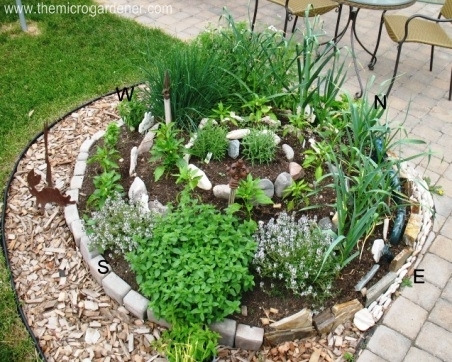
Organizing Your Spiral Garden
While there are seemingly endless types of Spiral Gardens, there are a few things they all have in common: They all start out with a region on the top, where water is bound to run off right away, leaving the soil relatively dry. This area is also the most exposed to the wind. Keep this in mind when choosing the plants that are going to live here. Ideally, the spiral should start sloping toward the East from here. Delicate plants that benefit greatly from the morning sun will appreciate this region. As the slope continues toward the South and West, it becomes more suitable for sun loving species. Finally, as the spiral reaches the ground level in the shady Northern part, it will be perfect for herbs that prefer less sun, more shade and more water, since the soil tends to be wetter here. (Note: This is for the Northern Hemisphere. In the Southern Hemisphere North and South are reversed.) To make full use of the runoff water, many people add a small pond at the base of the spiral, where additional aquatic plants, such as watercress, can be grown.

The given illustration offers a good number of herbs for a nicely diverse kitchen. Depending on what else you want in your Herb Spiral, you can add it in the most suitable region. Mint and lemon balm love the cooler, shady part with more water. Lemongrass is great in the sunny area, and tarragon and estragon prefer the dry top of the spiral. Of course, the idea is not limited to kitchen herbs. For maximalists, the same theory can work with a mountain you might want to terraform into a spiral farm. But right now I'd prefer to stay small scale.
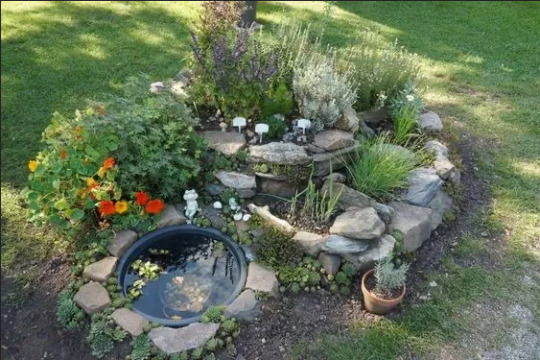
Plenty of Benefits (That's Why It's Permaculture)
As explained above, the main purpose of the Spiral Garden is not only to increase your gardening area by making use of the vertical, but also to create diverse climatic conditions, which do make a difference on the smallest scale. But as Permaculture tends to be, there are many other benefits to it. The structure itself offers great habitat for numerous animals, such as frogs, salamanders, lizards, but also pollinating insects, and of course others that may not directly benefit us, but by feeding on others they all add to the stability of our ecosystem. The structure itself will suppress weeds and make use of material that you're not likely to use elsewhere. Finally, depending on the size and location, it will be an ideal place to grow all your kitchen herbs right where you can access them most easily.

Some Things to Keep in Mind
When building the structure, make sure it will contain the soil in a nice trough, slanting slightly inward. That way bits and pieces that fall off will roll towards the center, until contained by the main mound.
Make sure the slope is always nice and gradual, avoiding sudden drops where the water can rush down quickly, eroding the soil.
If you're going to walk on your spiral, include a separate walkway that won't compress good soil. Most importantly, it should be sturdy enough to provide stability and make access safe.
Don't forget that while the structure is important to keep the soil in place, it is the soil that you'll be growing plants in. So it should have a good depth of 20-50 cm (8-20 inches) throughout the entire spiral. This can be the trickiest part!
Apply your own observation to which plants do better in which parts of the spiral. Also, with time you will find many other plants growing in it that you didn't plant. Before removing them, consider how much they actually bother your herbs, and whether their benefits may not outweigh their drawbacks.
Go Out and Build Your Own!
I hope this brief overview got you inspired to go out and try building an Herb Spiral yourself! I would love to hear your experiences with it!
Sources: 1, 2, 3, 4
3K notes
·
View notes
Text
yesterday I saw a patch of clover on my daily walk with my dog. I was looking for a four leaf clover among all the three leaf clovers and I stopped, and stooped down to look through them. Time seemed to stop for a while. I almost forgot where I was. When I stood up I realised, my inner child awakened for a little bit. It was like reliving my childhood. I didn't worry about anything other than seeing a three leaf clover. I really cried about it when I got home because I felt like a part of me who had died had come back to life for a brief moment. And that was when I vowed to get lost in a moment like that more often, to look for three leafed clovers, to be a child again.
0 notes
Text
i don't care about people calling me a transphobe and a bigot, i don't care about their crying posts and their insults, i don't care if they think i'm on the wrong side of history, i don't care about the feelings i am hurting, i don't care if they feel attacked or shocked by my words ; i believe gender ideology is pure nonsense, i believe it is based on misogyny, i believe it is a threat to women and girls, so i'll keep fighting against it. women and girls are my priority, and if a cult-like ideology starts to be have bad consequences for them, i don't see why i should shut up. i won't support its existence just because some people are delusional and think it's bigotry not to tell them what they want to hear
144 notes
·
View notes
Text

Charles Bukowski, "hurry slowly," from Come On In!
33K notes
·
View notes
Text
A Solarpunk Reading List
Fiction:
New York 2140 - Kim Stanley Robinson
Ecotopia - Ernest Callenbach
Always Coming Home - Ursula K. LeGuin
The Fifth Sacred Thing - Starhawk
Half-built Garden - Tessa Gratton
Future Home of the Living God - Louise Erdrich
The City, Not Long After - Pat Murphy
Too Like the Lightning - Ada Palmer
Walk to the End of the World - Suzy McKee Charnas
The Summer Isles - Ian R. MacLeod
Nonfiction:
The Transition Handbook: From Oil Dependency to Local Resilience - Rob Hopkins
Emergent Strategy - Adrienne Maree Brown
The Little Book of Conflict Transformation - John Paul Lederach
The Urban Farmer - Curtis Stone
Savoring the Seasons of the Northern Heartland - Beth Dooley
Everything for Everyone: The Radical Tradition that Is Shaping the Next Economy - Nathan Schneider
When Technology Fails: A Manual for Self-Reliance, Sustainability, and Surviving the Long Emergency - Matthew Stein
Biomimicry: Innovation Inspired by Nature - Janine M. Benyus
Papermaking with Garden Plants and Common Weeds - Helen Hiebert
Speculative Everything: Design, Fiction, and Social Dreaming -
720 notes
·
View notes
Text
Solarpunk - Dear Alice GIFs
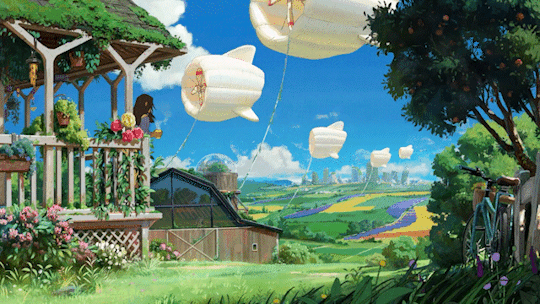





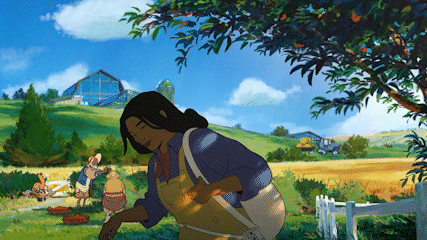
Source: Dear Alice - Chobani Ad
483 notes
·
View notes
Text

chen chen, nature poem in ‘when i grow up i want to be a list of further possibilities’
38K notes
·
View notes
Audio
and will you never cut the cloth, or drink the light to be? and can you never swear a year, to any one of we?
1K notes
·
View notes
Text


Jeanette Winterson, Written on the Body /@wormbus-art
948 notes
·
View notes


